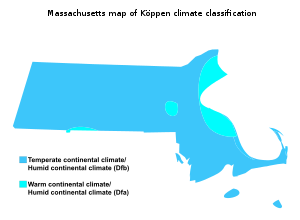Geography of Massachusetts
[1] It is bordered to the north by New Hampshire and Vermont, to the west by New York, to the south by Connecticut and Rhode Island, and to the east by the Atlantic Ocean and Gulf of Maine.
At the southeastern corner of the state is a large, sandy, arm-shaped peninsula, Cape Cod, which forms the southern boundary of the Gulf of Maine to the north.
[2] The Quabbin Reservoir (formed by the dammed Swift River—a former Connecticut River tributary), borders the western side of the county; it is the main water supply for Greater Boston.
[3][4] The Connecticut River Valley features Massachusetts'—and some of the northeastern United States'—richest soil, due to Ice Age deposits by glacial Lake Hitchcock.
Other cities in the Massachusetts portion of the New Haven-Hartford-Springfield arm of the Northeast megapolis include: Chicopee, Agawam, West Springfield, Westfield, Holyoke, and the college towns of Northampton, Amherst, and South Hadley.
The region was populated by Native Americans until the 18th century when Scotch-Irish settlers arrived, after having found the fertile lowlands along the Connecticut River settled.
On reaching the Berkshires, settlers found poor soil for farming, but discovered numerous fast-moving rivers for industry.
The Housatonic-Hoosic valley separates the Taconics from The Berkshires, a broad belt of steeply rolling hills that are a southern extension of the Green Mountains of Vermont.
This ancient rift valley appeared in the Mesozoic Era when North and South America broke away from Europe and Africa.
More than a hundred million years later, as the Pleistocene epoch ended, receding glaciers left moraines that dammed the Connecticut River, creating Lake Hitchcock.
This divide runs through central Massachusetts, though the summit of Mount Wachusett, the highest point in the state east of the Connecticut River, rising to 2,006 feet (611 meters).
Some of these form natural harbors that gave rise to the state's historic ports, including Newburyport, Gloucester, Salem, Boston, and New Bedford.
Average July temperatures in Massachusetts' three most populous urban centers are: Boston (coastal) - 81.7 °F (27.6 °C); Worcester (central) - 79.2 °F (26.2 °C); and Springfield (Connecticut River Valley) - 85.0 °F (29.4 °C).
Peregrine falcons utilize office towers in larger cities as nesting areas,[17] and the population of coyotes, whose diet may include garbage and roadkill, has been increasing in recent decades.
[16][19] In more rural areas in the western part of the state, larger mammals such as moose and black bears have returned, largely due to reforestation following the regional decline in agriculture.
[22] Lakes in central Massachusetts provide habitat for the common loon,[23] while a significant population of long-tailed ducks winter off Nantucket.
[24] Small offshore islands and beaches are home to roseate terns and are important breeding areas for the locally threatened piping plover.
Trees tend to grow around houses in this region, such that when one looks out over eastern Massachusetts from the top of a high hill, one sees a vista of treetops, punctuated only occasionally by a church steeple, smokestack, or radio tower.
American shad runs have retained at least a fraction of their former abundance, and smallmouth bass, sunfish, and pike populations are healthy enough to support angling.
At the same time, pollutants in waterways, mainly from urban sources, can be toxic to many species or may support algae and bacteria that lead to hypoxia and the death of aquatic animals.
However, Greater Boston boasts extensive parklands, and efforts have been made in Massachusetts to reduce environmental pollution in both urban and rural parts of the state.
According to the definitions of the U.S. Office of Management and Budget (OMB), all of Massachusetts falls within a metropolitan statistical area (MSA), except for the offshore islands of Martha's Vineyard and Nantucket.
However, population is growing fastest in the outer peripheries of the state's metropolitan areas, where new housing construction is adding dwelling units.
NECTAs take advantage of the administrative subdivision of the entire territory of Massachusetts and other New England states into towns and cities.
Each NECTA consists of a cluster of cities and towns defined by commuting patterns, which therefore correspond roughly to local labor markets.
This indicates either a higher labor participation rate in central Greater Boston or a surplus of commuters traveling to work from other parts of Massachusetts or neighboring states.
In the far southeastern corner of Massachusetts, the Barnstable Town NECTA, nearly coterminous with the summer resort region of Cape Cod, has an atypical employment structure.
Greater Boston is noted nationwide for its prestigious institutions of higher education, such as Harvard University and MIT, and the region is home to 77.8% of the state's higher-education employment.
Except for Lowell, these satellite NECTA divisions also have higher shares of employment in retail trade than central Greater Boston or Massachusetts as a whole.
The Framingham division, however, has the state's highest percentage of jobs in professional and business services (18.5% of employment versus 14.4% statewide), reflecting that region's strength in technology.







